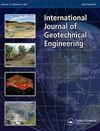Experimental investigations on the influence of embedment depth and frequency on the dynamic behaviour of tunnels under repeated shaking events
IF 1.3
Q2 ENGINEERING, GEOLOGICAL
International Journal of Geotechnical Engineering
Pub Date : 2023-05-28
DOI:10.1080/19386362.2023.2264055
引用次数: 0
Abstract
ABSTRACTRecently, occurrence of repeated shaking events such as the Kobe earthquake (1995), the Wenchuan earthquake (2008), the Chi-Chi earthquake (1999) and the Kumamoto earthquake (2016), Kahramanmaras earthquake (2023), etc., posed a severe threat to the safety of infrastructures. Studies on the influence of repeated shaking events on underground structures are minimal. Considering the above, tunnel-soil interaction under repeated shaking events is attempted in the study. One-gram shaking table tests were conducted in this study by varying loading frequency (5 Hz, 10 Hz) and tunnel embedment depth (H/W − 0.85 and 1.2 where H is the tunnel embedment depth and W is the width of the tunnel) and subjected to incremental shaking conditions, i.e. 0.2 g, 0.3 g and 0.4 g. A tunnel-embedded ground with 60% relative density was prepared and instrumented with conventional sensor schemes and a non-contact-based 2D digital image correlation technique. It was observed that the loading frequency and tunnel embedment influences tunnel’s performance during repeated shaking events. About 37% to 62.4% increment in tunnel displacement was observed in the case of H/W-0.85, and 20% to 29% increment in tunnel displacement was observed for H/W-1.2 when subjected to incremental acceleration shaking, i.e. 0.2 g to 0.4 g for varying embedment depth conditions.KEYWORDS: Tunnel-soil interactioninfluence of embedment depth of tunneluni-axial shaking table testsconventional monitoringdigital image correlation (DIC) AcknowledgmentsThe authors would like to thank the Director, CSIR-Central Building Research Institute, Roorkee, for giving permission to publish this research work. The authors would also like to thank the Head, Geotechnical Engineering Division, CSIR-CBRI for his continuous support during this research work.Disclosure statementThe authors declare that they have no known competing financial interests or personal relationships that could have appeared to influence the work reported in this paper.Author contributionsBoth the authors contributed to the study conception. Material preparation, data collection and analysis were performed by Amith K.S. The first draft of the manuscript was written by Amith K.S., then reviewed by Ganesh Kumar Shanmugam and commented. Both the authors have read and approved the final manuscript.Data availability statementSome or all data, models, or code that support the findings of this study are available from the corresponding author upon reasonable request.埋置深度和埋置频率对反复震动作用下隧道动力特性影响的试验研究
摘要近年来,神户地震(1995)、汶川地震(2008)、池池地震(1999)、熊本地震(2016)、Kahramanmaras地震(2023)等地震事件的反复发生,对基础设施的安全构成了严重威胁。关于反复震动事件对地下结构影响的研究很少。考虑到上述因素,本研究尝试了反复震动作用下隧道-土的相互作用。本研究通过改变加载频率(5 Hz、10 Hz)和隧道埋深(H/W−0.85和1.2,其中H为隧道埋深,W为隧道宽度),以及0.2 g、0.3 g和0.4 g的增量振动条件,进行了一克振动台试验。采用传统传感器方案和非接触式二维数字图像相关技术制备了相对密度为60%的隧道埋地。研究发现,荷载频率和隧道埋置对隧道反复振动时的性能影响较大。在H/W-0.85条件下,隧道位移增加37% ~ 62.4%,在H/W-1.2条件下,随着埋深的变化,隧道位移增加0.2 g ~ 0.4 g,隧道位移增加20% ~ 29%。关键词:隧道-土体相互作用隧道埋深影响单轴振动台试验常规监测数字图像相关(DIC)致谢作者感谢csir -中央建筑研究所主任允许发表本研究成果。作者也要感谢CSIR-CBRI岩土工程部主任在这项研究工作中一直给予的支持。披露声明作者声明,他们没有已知的竞争经济利益或个人关系,可能会影响本文所报道的工作。作者贡献两位作者都对研究概念做出了贡献。材料准备,数据收集和分析由Amith K.S.完成。手稿的初稿由Amith K.S.撰写,然后由Ganesh Kumar Shanmugam审阅和评论。两位作者都阅读并批准了最终稿件。数据可用性声明支持本研究结果的部分或全部数据、模型或代码可根据通讯作者的合理要求获得。
本文章由计算机程序翻译,如有差异,请以英文原文为准。
求助全文
约1分钟内获得全文
求助全文
来源期刊

International Journal of Geotechnical Engineering
ENGINEERING, GEOLOGICAL-
CiteScore
5.30
自引率
5.30%
发文量
32
 求助内容:
求助内容: 应助结果提醒方式:
应助结果提醒方式:


